 Offset Surface
Offset Surface
Introduction
This topic will explain the Offset Surface function, will explain where to find the function, and explain the options found in it. This topic will also explain creation with quick steps and an example, and provide links to related topics.
The Offset Surface Function
The Offset function creates an additional surface from an existing surface using the offset value as the distance between the two.You can also use this function to offset solid geometry.

Navigation
To open the Offset Surfaces function:
- In the Advanced Surfaces group, of the Create 3D tab, click
 Offset Surfaces.
Offset Surfaces.
The parameters display in the Data Entry Manager.
The Data Entry Parameters
Selected Geometry
|
|
|
| The list will display all entities currently selected for the function. | |
- Show Preview - Once geometry has been added to the Picked Entities list, clicking the Show Preview, displays the result that will be created when you click OK.
Hide Preview - When the preview is displayed, the Hide Preview option will replace it. Selecting the Hide Preview option will blank the preview.
Parameters
Distance - sets how far the selected geometry is offset. Negative values are supported to offset in the opposite direction.
Tip: The positive direction is the same as the surface normal direction of the selected surface.
 Options
Options
The Options group includes check boxes to allow you to control the creation of fillets and to keep or remove the original surface upon the creation of the offset. This group can be expanded and collapsed with the  , and
, and  icons.
icons.
![]() Fillet Edges - When cleared, sharp edges on the existing surface, will be retained.
Fillet Edges - When cleared, sharp edges on the existing surface, will be retained.
-
 Keep Original - When selected, this option retains the original surface when the offset surface is created.
Keep Original - When selected, this option retains the original surface when the offset surface is created.
![]() Keep Original -When cleared, this option will replace the original surface with the new offset surface.
Keep Original -When cleared, this option will replace the original surface with the new offset surface.
- OK - finalizes the function.
- Cancel - exits the function.
Quick Steps - Offset Surfaces
- Open the function.
The Selected Geometry list is automatically given focus. - Select the surfaces to offset.
The surfaces are added to the Selected Geometry list. - Select the Show Preview button to see a preview of the offset.
- Set the desired parameters.
The preview updates. - Click OK to create the offset.
The feature is added to the CAD Tree. - Repeat as necessary.
Tip: Instead of applying features to solids and surfaces more than once, go to the CAD Tree to edit the existing feature. Since all solid and surface moves, and modifications are stored in the CAD Tree, editing a feature is preferable to adding many more to achieve the desired result. This will keep file size down and help ensure files don't become slow to respond.
- Click Cancel to exit the function.
Example
In this example, you will create geometry and then learn how to use the Offset Surface function on that geometry. This example will have you:
-
Create a Cube
-
Unstitch the Cube
- Move to the Front Plane
- Create a Rectangular Plane
- Create an Arc
- Move to the Top Plane
- Extrude the Arc
- Offset Without Keeping the Original
- Offset and Keep Original
- Offset with Filleted Edges
Note: In the images below, both the Show Axis X-Y and Show Gnomon toggles have been disabled in the Axis X-Y group of the Settings Part > Display dialog.
Part 1) Create a Cube
-
In the Quick Access Toolbar, click
 New.
New.
A new document opens. -
Enter into an ISO2 view by pressing Ctrl+7.
-
In the Primitives group, of the Create 3D tab, click
 Cube.
Cube.
The Cube parameters display in the Data Entry Manager.
The Preview appears.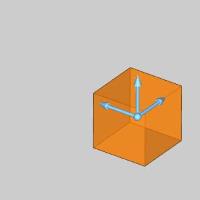
-
The cube being created will be left at the default size, and location.
Click OK to confirm the cube.
The Cube is created in the graphics area and a Cube feature is created in the
Cube feature is created in the  CAD Tree.
CAD Tree.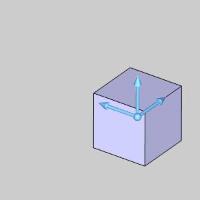
Part 2) Unstitch the Cube
-
In the Modify group, of the Create 3D ribbon, click the down arrow for
 Stitch Surfaces to Solid, and select
Stitch Surfaces to Solid, and select  Unstitch Surface from Solid.
Unstitch Surface from Solid. -
Hover over the surface as seen in the image below.
The surface highlights.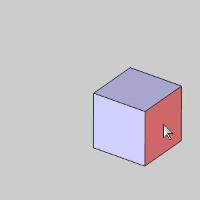
-
Click the surface.
The surface is added to the Selected Geometry list.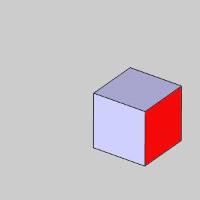
- Click OK.
The surface is no longer highlighted until the mouse is moved again.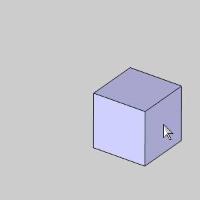
No change is visible, but the surface is unstitched from the cube and an Unstitch Surface from Solid feature is created in the
Unstitch Surface from Solid feature is created in the  CAD Tree.
CAD Tree. -
Click Cancel to exit the function.
-
Hover of a different surface of the cube as seen in the image below.
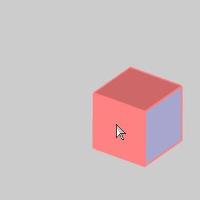
Notice the surface has been unstitched from the cube.
Part 3) Move to the Front Plane
-
In the UCSManager, click Front (X/Z) in order to create another surface on the Front Plane.
The Front Plane highlights.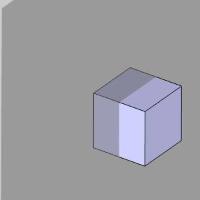
Part 4) Create a Rectangular Plane
-
In the Surfaces group, of the Create 3D ribbon, click the down arrow under
 Planar, and select
Planar, and select  Rectangular Plane.
Rectangular Plane.
The Rectangular Plane dialog opens in the Data Entry Manager. -
In the Base Point group, change the Z value to -2.0000.
The preview updates.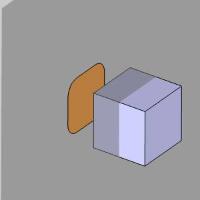
-
Click OK to confirm placement of the Rectangular Plane.
The surface is created in the graphics area and a Rectangular Plane feature is added to the
Rectangular Plane feature is added to the  CAD Tree.
CAD Tree.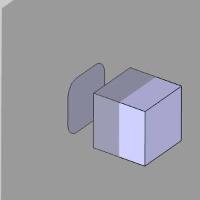
Part 5) Create an Arc
-
In the Entity group, of the Create 2D ribbon, click the down arrow under
 Arc, and select
Arc, and select  Arc Center.
Arc Center.
The Arc Center dialog opens in the Data Entry Manager and the Preview displays.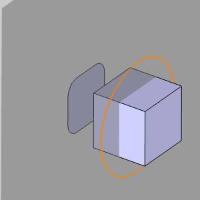
-
Update the values in the Arc Coordinate dialog to match the following:
|
Center X Center Y Center Z Radius Start Angle End Angle |
= 0.0000 = 0.0000 = -3.0000 = 1.0000 = 0.0000 = 180.0000 |
The Preview updates.
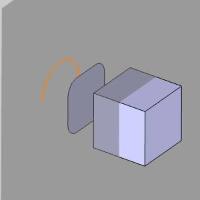
-
Click OK to confirm the placement of the arc.
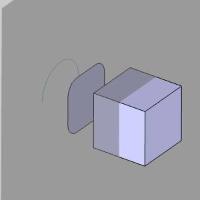
Part 6) Move to the Top Plane
-
In the UCS Manager, click Top (X/Y) to set it as the active UCS.
The Front Plane disappears.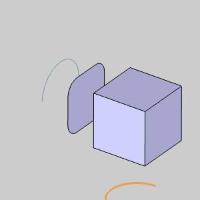
Part 7) Extrude the Arc
-
In the Extrude group, of the Create 3D ribbon, click
 Extrude Curve.
Extrude Curve.
The Extrude Curve dialog opens in the Data Entry Manager. -
Hover over the arc as seen in the image below.
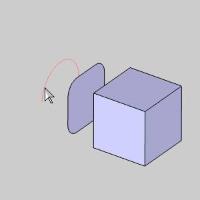
-
Click the arc.
The Preview appears.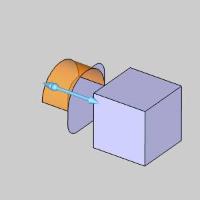
-
In the Positive Direction group, change the Distance value to 0.0000.
The Distance in the Other Direction group automatically becomes 1.0000,and the preview updates.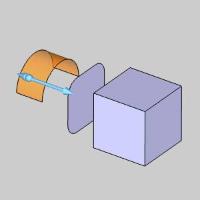
-
Click OK to create the Extrude Curve.
The Extrude Curve is created in the graphics area and an Extrude Curve feature is added to the
Extrude Curve feature is added to the  CAD Tree.
CAD Tree.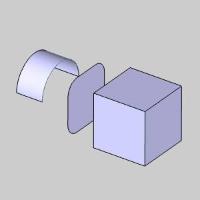
Part 8) Offset Without Keeping the Original
-
In the Advanced Surfaces group, of the Create 3D tab, click
 Offset Surfaces.
Offset Surfaces.
The Offset Surface dialog opens in the Data Entry Manager. -
Hover over the extruded arc as seen in the image below.
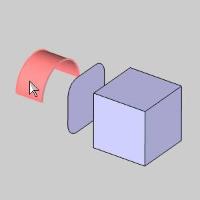
-
Click the surface.
The surface is selected and is added to the Selected Geometry list.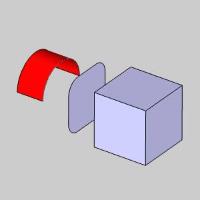
-
In the Parameters group, change the Distance to 0.5000.
-
Next to Options, click
 to access the options if nothing is visible.
to access the options if nothing is visible. -
Clear the checkbox for Keep Original.
The offset we create will now replace the original surface. -
Click Show Preview.
The Preview appears.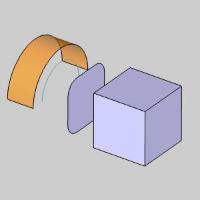
-
Click OK to confirm the surface.
The offset is created in the graphics area and an Offset Surface feature is created in the
Offset Surface feature is created in the  CAD Tree.
CAD Tree.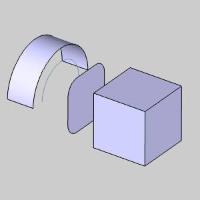
Part 9) Offset and Keep Original
-
Hover over the rectangular plane as seen in the image below.
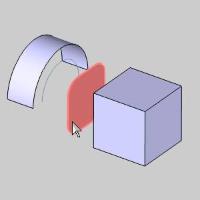
-
Click the rectangular plane.
The rectangular plane is added to the Selected Geometry list.
With the Show Preview button still selected, the Preview automatically appears.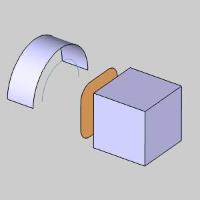
-
In the Parameters group, change the Distance value to -0.5000.
The Preview updates.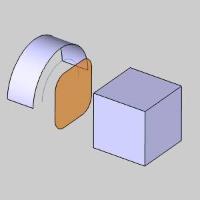
-
In the Options group, select the checkbox for Keep Original.
The offset we create will now be in addition to the original surface. -
Click OK to confirm.
The offset is created in the graphics area and an Offset Surface feature is created in the
Offset Surface feature is created in the  CAD Tree.
CAD Tree.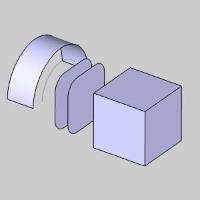
Part 10) Offset with Filleted Edges
- In the Options group, clear the check box for Fillet Edges.
- Hover over the cube as seen in the image below.
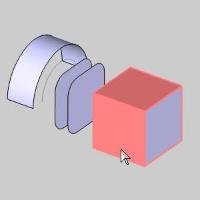
- Click the cube.
The cube is selected and added to the Selected Geometry list.
The Preview appears.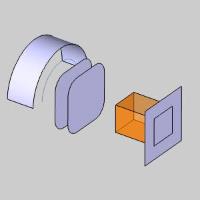
- In the Parameters group, change the Distance value to 0.5000.
The Preview updates.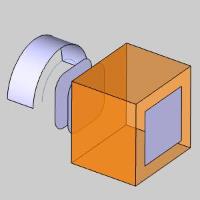
- In the Options group, select the check box for Fillet Edges.
The Preview updates.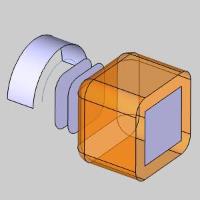
- Click OK to confirm.
The offset is created in the graphics area and another Offset Surface feature is created in the
Offset Surface feature is created in the  CAD Tree.
CAD Tree.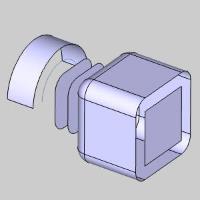
- To end this function, click Cancel.
This concludes the example.






 (Delete All)
- removes all entities from the Selected Geometry list.
(Delete All)
- removes all entities from the Selected Geometry list.